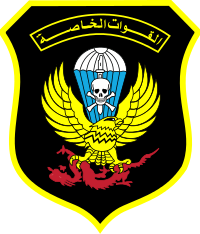Al-Saiqa (Libya)
The Libyan Special Forces, (Arabic: القوات الخاصة الليبية), less formally known as Al-Saiqa (الصاعقة; English: lightning, thunderbolt) are an elite Libyan National Army unit, formed from a mixture of paratroopers, paramilitary forces and commandos. (They should not be confused with the similarly named Lightning Bolt Brigade (Sawaiq Brigade) which is part of the Zintan Brigades.) Prominent al-Saiqa commander Mahmoud al-Werfalli was indicted in 2017 and 2018 by the International Criminal Court for the war crime of murdering and ordering the murders of non-combatants,[2][3] remaining at large as of 6 April 2019.[4]
| Al'Saiqa | |
|---|---|
| Participant in Libyan Civil War (2011) and Factional violence in Libya (2011–2014) | |
 Libyan Special Forces Emblem. | |
| Active | 1964 – present |
| Founder | Abdel Fatah Younis |
| Leaders | Wanis Bukhamada |
| Headquarters | Benghazi |
| Area of operations | Benghazi |
| Size | Up to 5,000 soldiers[1] |
| Allies | |
| Opponent(s) | Shura Council of Benghazi Revolutionaries |
| Battles and war(s) | Libyan Civil War (2011) 2013 Benghazi conflict Libyan Civil War (2014–present) |
Origins
The pro-government force emerged from a militia in 2010, during the Muammar Qaddafi government. In the 1990s, al-Saiqa helped to suppress the rebellion of Libyan Islamic Fighting Group.
Composition and hierarchy
As of March 2014, al-Saiqa numbered about 5000 soldiers and reported to the Ministry of Defence.[5]
In 2013, the Al-Saiqa commander was Colonel Wanes Abu Khamadah. From 2011 to at least 2017, Mahmoud al-Werfalli was a member of al-Saiqa. Since December 2015, he held positions of command responsibility. As of August 2017, his title was Axes Commander and he held responsibility for at least one detention centre.[2] In 2017 and 2018 he was indicted for the war crime of murdering and ordering the murders of non-combatants by the International Criminal Court (ICC) under Article 8(2)(c)(i) of the Rome Statute.[2][3] As of 6 April 2019, the ICC warrants for his arrest remained outstanding.[4]
Benghazi Clashes
Al-Saiqa came to prominence after its deployment in Benghazi in summer 2013, in an attempt to control the growing disorder. As a result, it came under repeated attacks and several of its officers killed. The force is reportedly popular in Benghazi,[5][6] particularly in light of its stance against the Islamist Ansar al-Sharia group and because it is seen as a symbol of the reborn Libyan armed forces.
The Al-Saiqa Brigade reportedly has had frictions with the Libya Shield Force, a government-sanctioned powerful militia;[6] despite these frictions, between November and December 2013 the Al-Saiqa Brigade fought the Ansar al-Sharia militia,[7] suffering some losses.[8]
At the end of July 2014 the Brigade was pushed out of its main base in Benghazi's Buatni district by Islamist fighters from the Shura Council of Benghazi Revolutionaries. A senior Saiqa official later claimed to the Libya Herald that Saiqa losses in Benghazi between the 21 and 30 July totaled some 63 dead and 200 wounded. Whilst the official was unsure of the number of Islamist dead, he claimed that it was in the dozens.[9]
By 13 August 2014 the Saiqa presence in Benghazi was almost entirely limited to Benina Airport; the base of Operation Dignity's helicopter unit. Many of the forces top commanders were in turn operating out of the Operation Dignity stronghold of Tobruk.[10]
Related voices
References
- Finucci, Francesco. "Libya: military actors and militias" (PDF). Global Security. Retrieved 20 March 2014.
- "ICC-01/11-01/17: The Prosecutor v. Mahmoud Mustafa Busayf Al-Werfalli Warrant of Arrest" (PDF). International Criminal Court. 2017-08-15. Archived (PDF) from the original on 2019-04-15. Retrieved 2017-08-16.
- The Office of the Prosecutor (9 May 2018). "Fifteenth report of the prosecutor of the International Criminal Court to the United Nations Security Council pursuant to UNSCR 1970 (2011)" (PDF). International Criminal Court. Archived (PDF) from the original on 14 April 2019. Retrieved 9 April 2019.
- "Libya: Threat of Tripoli Fighting Raises Atrocity Concerns — Hiftar's Forces, Rival Militias Have History of Abuses". Human Rights Watch. 6 April 2019. Archived from the original on 9 April 2019. Retrieved 9 April 2019.
- "Guide to key Libyan militias and other armed groups". BBC. Retrieved 20 March 2014.
- Algattani, Ali (2013-07-31). "Benghazi faces tough task securing streets". Magharebia. Retrieved 20 March 2014.
- McGregor, Andrew. "LIBYAN SPECIAL FORCES EXPEL ANSAR AL-SHARI'A FROM BENGHAZI". Aberfoyle International Security. Retrieved 20 March 2014.
- Burweila, Aya. "Libya, Syria, and the Resurgence of Al-Qaeda". The Jerusalem Review. Retrieved 21 March 2014.
- Amzein, Aimen (11 August 2014). "Sixty-three Saiqa members killed and 200 wounded in July fighting". Libya Herald. Benghazi. Retrieved 14 August 2014.
- Ibrahim, Noora (13 August 2014). "Ansar increases presence at Benina check-point as criticism of Saiqa mounts". Libya Herald. Benghazi. Retrieved 14 August 2014.